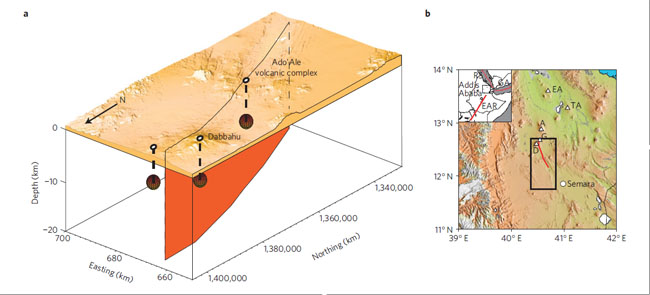Stress transfer between thirteen successive dyke intrusions in Ethiopia by I.J. Hamling et al, 2010
Non-technical summary
It has been known for some time that a large earthquake has a role to play in triggering subsequent earthquakes. A similar effect has been suggested for magmatic dyke intrusions (where hot molten rock is injected along narrow, vertical cracks in the Earth's crust) but until now, the opportunities to study this have been limited. The intrusion of a 60-kilometre-long magmatic dyke along the African-Arabian plate boundary in September 2005 marked the beginning of a series of dyking events which provided an ideal chance to study this phenomenon. Between June 2006 and July 2009 twelve more dykes were emplaced at depths between two and nine kilometres in the crust. By monitoring levels of tension around these dykes using mathematical modelling, GPS and InSAR data (measures changes in the height of the Earth's surface) it was shown that subsequent eruptions were more likely to occur in places where the tension in the Earth's crust had been increased by these previous events. This information can be used to more accurately predict the sites of future volcanic eruptions and so can be included in routine volcanic hazard monitoring.

a) 3D projection of the main dyke beneath the Dabbahu rift segment. The rectangular region shows the location of the dyke and the orange spheres represent the magma chambers. b) Map of Afar showing the location of the dyke (red line) intruded in 2005, Gabho (G), Dabbahu (D), Alayta (A), Ado'Ale (A'A), Tat'Ale (TA) and Erta'Ale (EA) volcanoes (white triangles) and Semara, the regional capital (white circle).
Full paper (PDF file)
